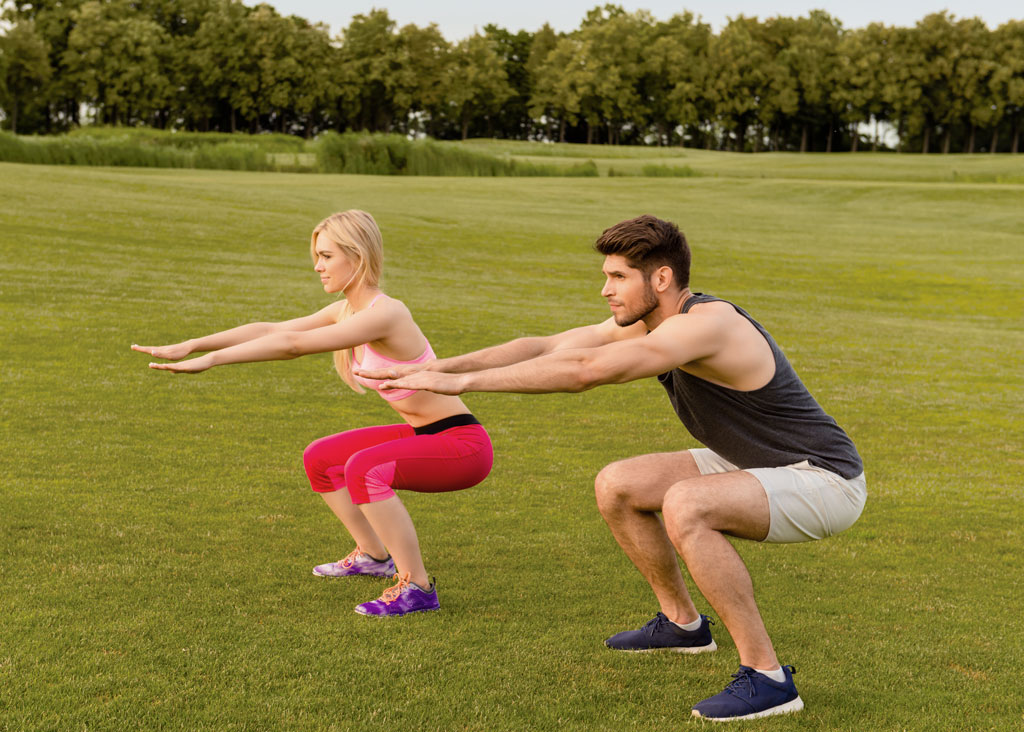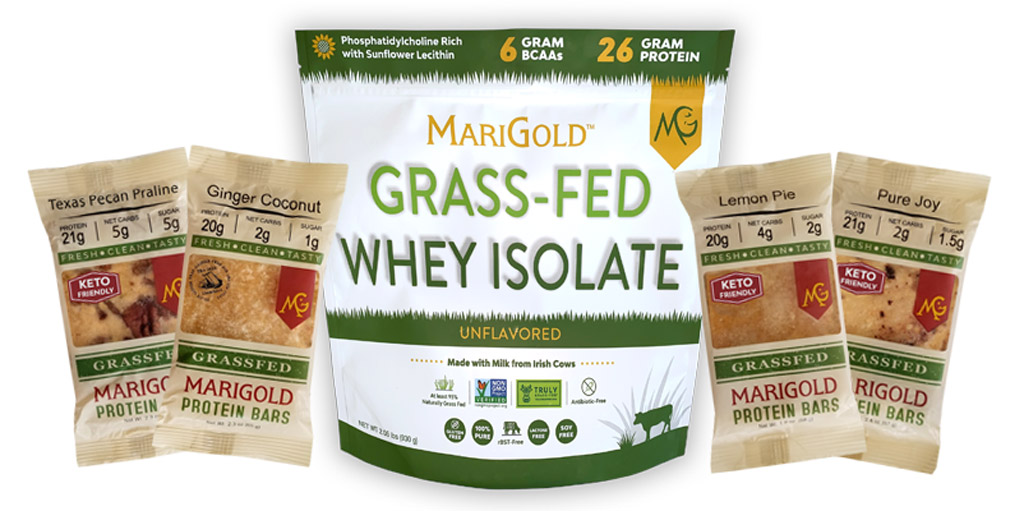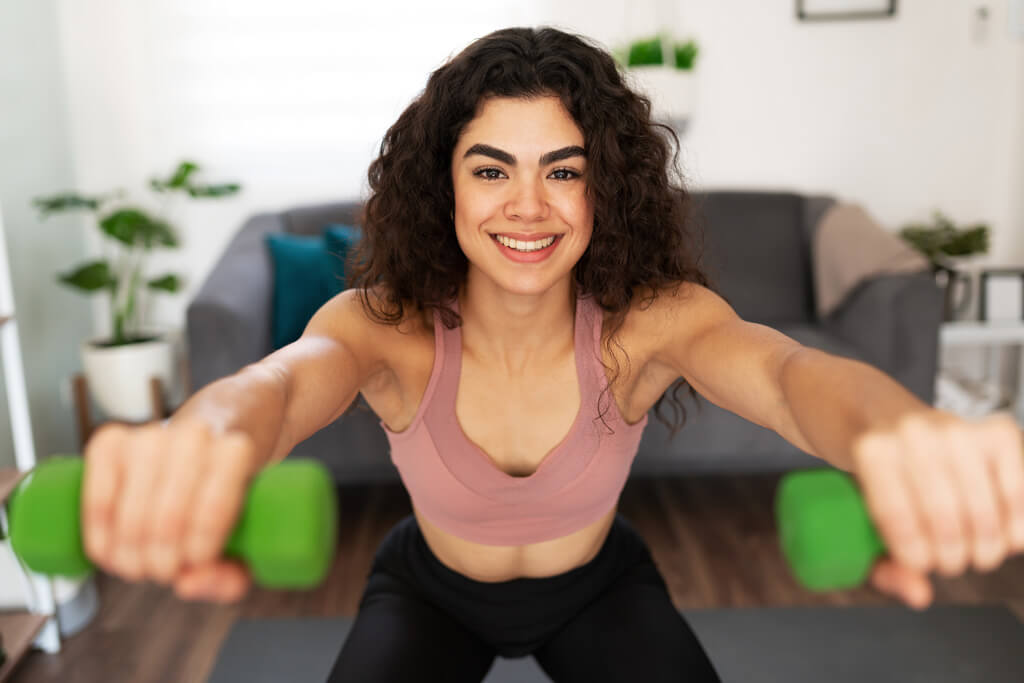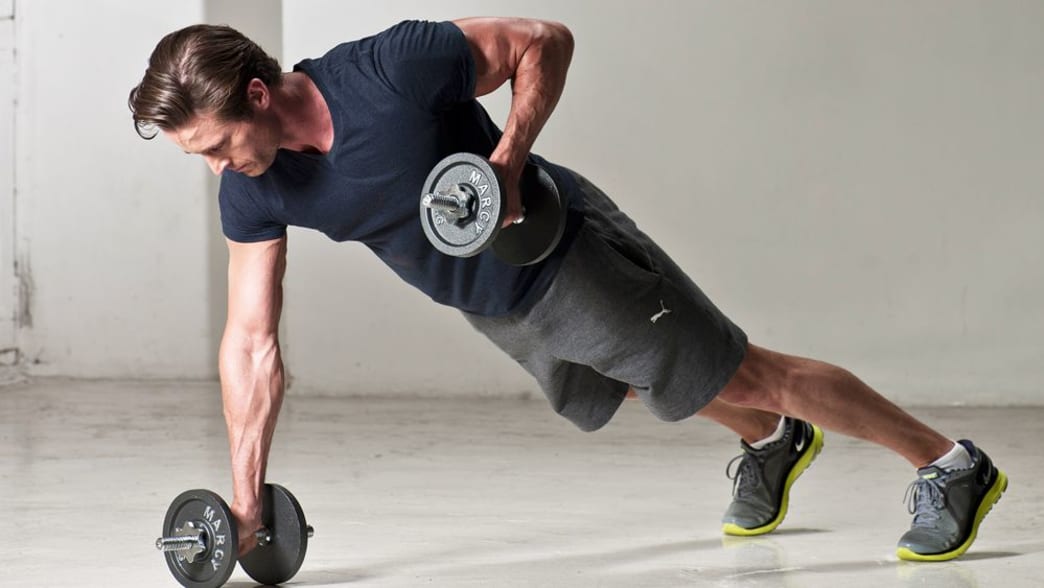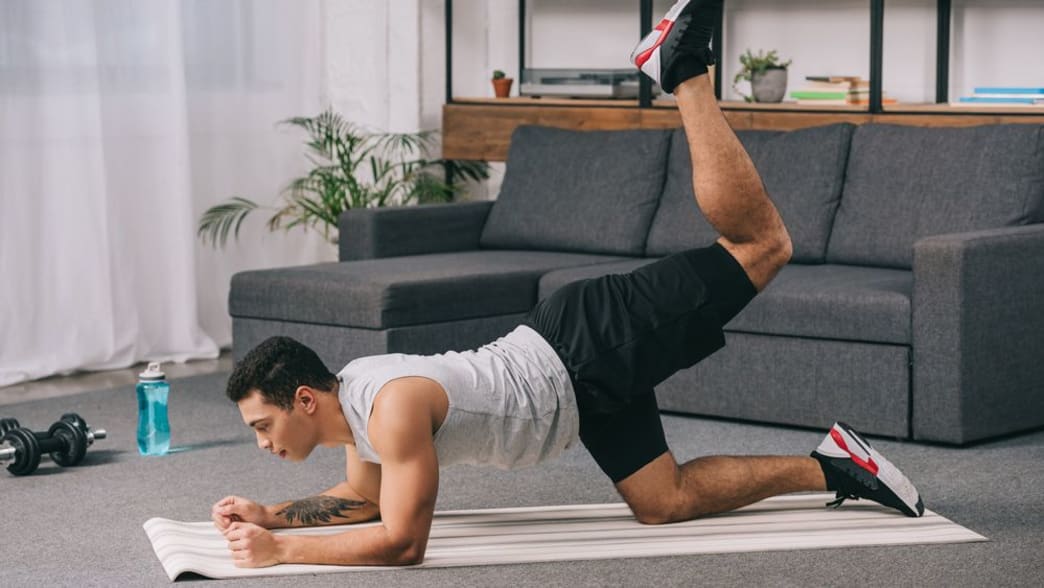When performed properly, squats and all their MANY variations are a great exercise for the whole body. In addition to your quads, hamstrings and calves, they also work your glutes, core and back muscles. By adding dumbbells you can work your arms simultaneously, or you can even sneak in cardio by upping the tempo or doing squat jumps.
Here’s how to squat and 14 variations to mix it up for your daily routine!
The king of all leg exercises uses many different muscle groups and should be in everyone’s repertoire.
Everybody squats – from fitness class newbies to bodybuilders, from parkrunners to Mo Farah – and part of the reason for that is there are dozens of ways to perform the exercise, with different variations being better for different fitness levels.
But what unites all the variations is that they’re all terrific compound exercises. Squatting is a movement that works multiple muscle groups and joints at the same time. It’s incredibly efficient because it hits pretty much the whole lower body in one fell swoop. It works your glutes, quads, hamstrings and calves hard, while also strengthening the smaller stabilizer muscles and the ligaments that support your main leg muscles.
Squats also increase the mobility in your ankles and hips, which – in combination with the strength benefits – can help to reduce your risk of injury when playing sports. And it’s not just the lower body that benefits from the squat: the move works your core too, and with so many large muscles involved you’ll find that rattling through a set of squats also gets your heart pumping, helping you to burn calories and improve your cardiovascular fitness.
No doubt hearing about all those benefits has left you raring to start squatting right away, so let’s dive straight in with the basic, unweighted squat. Once you’ve mastered that, read on for our favorite variations of the exercise, including several challenging weighted squats.
How To Squat
Even if you plan on trying each and every one of the many weighted squat variations listed below, it’s wise to start by nailing your form with an unweighted squat – also known as a bodyweight or air squat.
Begin by standing with your feet hip-width apart. Hold your arms out in front of you, or fold them across your chest, or even stick them out to the sides. They can go anywhere but on your legs.
Brace your core and lower until your thighs are parallel to the ground. Imagine you’re sitting back into an invisible chair. If you want to and it feels comfortable, you can continue to lower past this point into a deeper squat. If you’re concerned that you’re not dropping low enough with your squats, put a box or chair behind you that’s at or just below knee height, then lower until you just touch it with your bum to ensure you’re reaching the required depth. Drive through the heels to stand up and complete the rep.
Squat Form Tips
1. Toes
“You want your toes to point the way that feels most natural, either straight forward or to the sides,” says Adam Hayley, PT at Ultimate Performance. “If squatting feels tight or restricted, try pointing your toes to ten and two to align your feet with your thighs and improve ankle mobility.”
2. Heels
“Your heels are your main point of contact with the ground when squatting, and you should drive through them hard when you start to move back up,” says Hayley. “If you have very poor ankle mobility you can elevate your heels on weight plates to squat deeper.”
3. Knees
“You never want your knees to roll inwards because it’s a fast route to problems,” says Hayley. “When you stand back up, focus on pushing your knees out to the sides to activate more stabilizing muscles to keep your body stable for more power output.”
Squat Variations
Box squat
All you need for this variation is a box and your bodyweight. The lower the box, the harder the exercise will be. Stand just in front of your box and raise one leg in front of you for more difficulty. Lower onto the box until your glutes are resting on the surface. After 1-2 sec, drive back up using your heels and hips.
Sumo squat
This variation shifts the focus of the squat to your inner thighs and glute muscles, and all you have to do is widen your stance a little. Stand with your feet wider than shoulder-width apart and your toes pointed at a 45° angle. Lower into a squat, then push back up.
Squat jump
One of the key performance benefits of the common-or-garden squat is explosive power. To get more of that benefit, and quicker, add squat jumps to your routine. Drop into a squat, then explode upwards by driving through the heels while contracting your hamstrings, glutes and quads. Keep your back straight and land softly with a slight bend in your legs to avoid injury.
Squat thrust
The squat thrust is basically a slightly less demanding burpee, and so it works muscles all over the body as well as ramping up your heart rate. From a standing position, drop into a squat and put your hands on the ground in front of you, kicking your feet out behind you so you finish in a press-up position. Then jump your feet back up to your hands and stand up.
Split squat
Putting extra focus on one leg with the split squat not only increases the benefits of squatting for that leg, but also challenges your core stability. From a standard squat position take one big step backwards, with your heel raised so your back foot is on its toes. Lower slowly until your back knee is almost touching the ground, then rise back up.
Bulgarian split squat
If you really want to challenge your core, elevate the back leg in a split squat, which ups the load on your front leg and tests your balance all the more. The form is the same as the split squat, but you rest your back foot on a bench or step that’s around knee height.
Cossack squat
When is a squat not a squat? When it’s virtually indistinguishable from a type of lunge. The Cossack squat tests the definition of the exercise to its limit – and tests your flexibility to a similar extent. Even if you’re as strong as an ox and lifting big weights with your standard squats, the Cossack variation is a useful addition to your workout routine to ensure your mobility is just as impressive.
To perform the exercise, take a big step to the side as you would for a side lunge. Keep your weight in your heels as you start to sit back and down, with your trailing leg straight. Lower until the thigh on your bent leg is parallel to the ground or ideally lower, then push back up while maintaining your wide stance (unlike in the side lunge where you would step your feet back together).
It’s certainly best to start with a bodyweight version of the Cossack squat to check you have the mobility to go deep into the position and get back up. Add weight once you’re comfortable with the movement.
Single-leg squat
Squatting on one leg greatly increases the difficulty of the exercise and makes it more beneficial to sporty types, because it strengthens the muscles in a way that will add more power to your running and make you more resistant to injury. Stand on one leg with the raised leg held slightly behind you, and squat down as low as you can without toppling over. Hold both arms out in front of you to help with your balance when you first attempt the exercise.
Pistol squat
A particularly challenging version of the single-leg squat. With the pistol squat you hold the raised leg out straight in front of you and lower all the way down until the hamstring on your standing leg touches the calf. It’s a test of your mobility as well as your strength and it’s not an exercise for beginners – be sure to master the standard single-leg squat before reaching for the pistol.
Goblet squat
The goblet squat can be performed with a kettlebell or dumbbell, which should be held to your chest with your elbows tucked in. The goblet squat is a good way for beginners to add weight to their squats while ensuring they maintain correct form, and acts as a stepping stone from air squats to barbell back and front squats. Keeping the weight close to your chest is also beneficial for your back stability and core strength.
Back squat
The daddy of compound lifts, the back squat does it all when it comes to strengthening your lower body, boosting the benefits of the movement through the increased challenge of the weight. Start with the barbell resting on your rear shoulder muscles, then lower into a squat and power back up, keeping the weight on your heels as you do.
Front squat
A natural progression from the goblet squat, the front squat puts more focus on the quads than the back squat, and also challenges the core which is constantly working to keep the upper body balanced. The key in this lift is to create a “shelf” across the front of your shoulders where you can safely hold the barbell. Focus on keeping your elbows up and pointing forwards – this ensures the bar won’t pull you forwards.
Landmine squat
Fed up with holding the barbell in the middle? Then try the landmine squat. Load up one end of a bar and hold it in both hands in front of your chest, with the other end on the floor. Then lower into a squat. The landmine squat allows you to lift a lot of weight without putting so much pressure on your joints.
Overhead squat
When you’ve mastered every other squat going, give the very tricky overhead squat a go to increase the challenge to your legs and core. Stand holding a barbell overhead with your hands shoulder-width apart and your arms straight. Then squat. Good luck.
Written by Coach Staff for Coach and legally licensed through the Matcha publisher network. Please direct all licensing questions to legal@getmatcha.com.
Featured image provided by Coach
Refuel Your Muscles with MariGold
If you’ve ever done squats before, whether it was the first time or you’re a seasoned “squatter”, you most likely have felt the soreness in your muscles afterward. While being an incredibly effective exercise, squats can sometimes leave you walking like a waddling penguin!
That’s why it’s very important to make sure you feed your muscles what they need after an intense workout: protein. Protein after a workout can help to give your body the amino acids it needs to repair and rebuild muscle tissue.
MariGold Whey Isolate Protein Powder is 100% pure, has 26 grams of protein per serving and is non-GMO, rBST free, and is lactose, soy and gluten free. It is also cold processed and micro filtered, leaving it UNDENATURED and incredibly creamy. Then it’s INSTANTIZED, with choline rich sunflower lecithin, so it can easily be mixed with water, or any of your favorite morning and afternoon smoothies or drinks for a great protein boost.
Be sure to also check out our protein bars for an energy boost before or after a workout. They contain the same premium quality protein powder and are packed with 20+ grams of protein. They are very low sugar – most of our bars have 1g of sugar or less! We also include good-for-you fats like organic coconut oil and organic grass-fed ghee. They also contain extra L-Glutamine, which can also reduce fatigue and improve exercise recovery!


